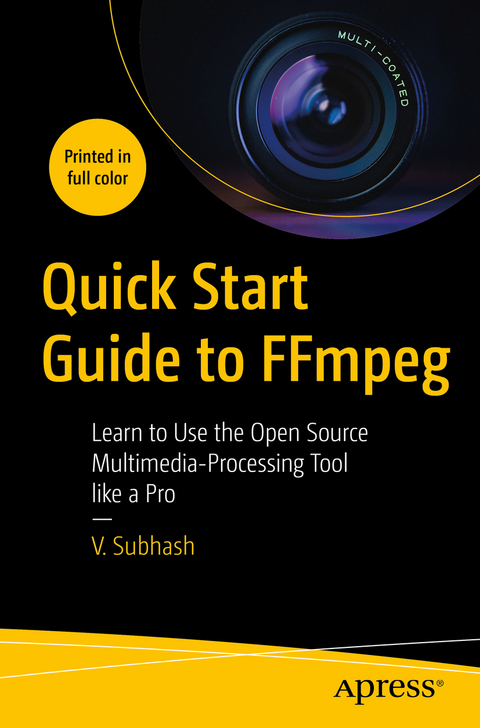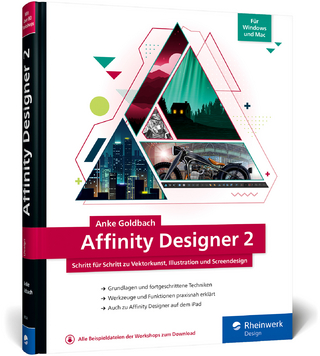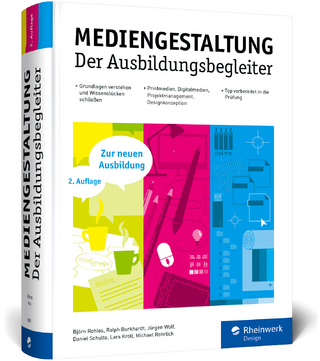
Quick Start Guide to FFmpeg
Apress (Verlag)
978-1-4842-8700-2 (ISBN)
It begins with a simple introduction to FFmpeg executables — ffmpeg, ffprobe and ffplay, and explains how you can use them to process multimedia containers, streams, audio channels, maps and metadata. It then describes how you can easily edit, enhance and convert audio, video, image and text files. There are dedicated chapters for filters, audio, subtitles and metadata, as well as FFmpeg tips and tricks. Sample lists of FFmpeg filters, encoders, decoders, formats and codecs are also available as appendices.
Quick Start Guide to FFmpeg is for anyone who needs to edit or process multimedia files including studio professionals, broadcast personnel, content creators, podcasters, librarians, archivists and webmasters. It will be indispensable for those wanting to process a variety of multimedia files from the command line and inside shell scripts or custom-built software.
You Will Learn To:
Convert from one format to another e.g. video-to-video, video-to-audio, video-to-image, image-to-video, video-to-animation, animation-to-video, text-to-audio, text-to-video
Edit video files by cutting them with and without re-encoding, appending, resizing, changing frame rate and aspect ratio, mixing in audio
Use filters to rotate, flip, crop, overlay (side-by-side or inset), remove logos, blur, smooth and sharpen, apply transitions as well as speed up or down playback
Edit audio files by changing, normalizing or compressing volume, mixing and splitting channels and detecting silence. Also, learn to generate waveforms as video or images
Add subtitles, place them anywhere on the screen, use custom fonts and colors, and use different languages
Learn how to import, export and remove metadata, add MP3 tags (including album art), set global and stream-specific metadata, export and remove metadata
This Book For:
Content creators and bloggers from professional studio employees to Youtubers and hobbyists who need to process their own multimedia content; multimedia archivists and librarians; regular Linux desktop users
V. Subhash is an Indian writer, programmer and illustrator. He is the author of over two dozen mostly non-fiction books including Linux Command-Line Tips & Tricks, CommonMark Ready Reference, PC Hardware Explained, Cool Electronic Projects and How To Install Solar. He wrote, illustrated, designed and produced all of his books using only open-source software. Subhash has programmed in more than a dozen languages (as varied as assembly, Java and Javascript); published software for desktop (NetCheck), mobile (Subhash Browser & RSS Reader) and web (TweetsToRSS); and designed several websites. As of early 2023, he is working on a portable Javascript-free CMS using plain-jane PHP and SQLite. Subhash also occasionally writes for Open Source For You magazine and CodeProject.com.
Chapter 1: Installing FFmpeg.- 2: Starting with FFmpeg.- 3: Formats and Codecs.- 4: Media Containers and FFmpeg Numbering.- 5: Format Conversion.- 6: Editing Videos.- 7: Using FFmpeg Filters.- 8: All About Audio.- 9: All About Subtitles.- 10: All About Metadata.-11: FFmpeg Tips 'n' Tricks.- Chapter 12: Annexures.
| Erscheinungsdatum | 07.02.2023 |
|---|---|
| Zusatzinfo | 90 Illustrations, color; 5 Illustrations, black and white; XXI, 280 p. 95 illus., 90 illus. in color. |
| Verlagsort | Berkley |
| Sprache | englisch |
| Original-Titel | FFMPEG Quick Hacks |
| Maße | 155 x 235 mm |
| Themenwelt | Mathematik / Informatik ► Informatik ► Grafik / Design |
| Schlagworte | audio convertor • Cross Platform • editing tool • FFmpeg • Filters • FOSS • Metadata • Mulimedia • multimedia production • Open Source • video convertor |
| ISBN-10 | 1-4842-8700-2 / 1484287002 |
| ISBN-13 | 978-1-4842-8700-2 / 9781484287002 |
| Zustand | Neuware |
| Haben Sie eine Frage zum Produkt? |
aus dem Bereich


